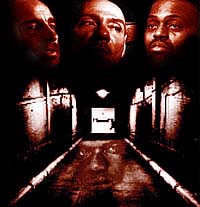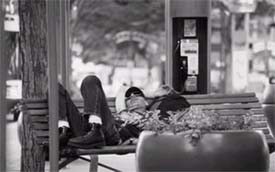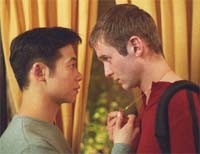
|
21st International Film Festival
Director Josell Ramos creates neither an aesthetically fresh or historically incisive documentary. However, Maestro demonstrates two important qualities of low-budget video. Maestro offers an introduction to a culture outside the mainstream - complete with rare footage from the era. Even more significantly, Ramos provides a forum for the reminiscence of those who lived to tell their tales. Regarding "the scene," one woman says: "It made us who we are today." In the same way that the DJs transformed music, the music promised to transform ideas about living. AIDS, drug addictions, and commercialization marked the end of the dream. That makes these testimonials of survivors even more precious - and inspiring. A dream deterred, but not forgotten.
Experimental documentary Accidental Insolence and home-video Southern Family play with Out in the Cold. Accidental Insolence makes an intriguing connection between The Emperor's New Clothes and media-indoctrinated homophobia - but it never really excites new vision. Southern Family recounts an extended family's reaction to the director's coming out. It has a great-grandmother/great-grandson hug that made me cry. Mike Hoolboom directs the most radical documentary of the festival. Tom is about Tom Chomont, an experimental film and video artist. Hoolbloom isolates and manipulates film footage to investigate Chomont, visual media, and desire. Sometimes, it's rather piquant - as in early film footage of bystanders staring into the camera. Sometimes, it's just silly - as with black and white footage from Independence Day. If none of these documentaries reconcile expectations of erudition, entertainment, and esthetics, the narrative videos are even worse. It should shock readers to discover that some film critics occasionally review movies that they've only seen on video screener tapes. Such critics hide their lack of respect for the art, the profession, and - most importantly - the audience. It's a totally despicable ruse. Critic and audience visual literacy is pretty much at an equal nadir in 2002. Such practices only prove and - insidiously - perpetuate that fact. To better explain the difference, allow me to use an analogy. Film, as a medium, is to video as Erasure's Andy Bell's voice is to Madonna's. Only a deaf person would confuse the two. And only a blind person would confuse (and misuse) video for film.
His memory proves embarrassingly flawless in the truth-or-dare style threesome between two closeted high school boys and a female classmate. Maccubin renders these observations pointless. His fatalistic philosophy matches his dull graphic imagination. More power plays in the bogus psychological play adaptation, Fixing Frank. Director Michael Selditch fails to explain why the Frank of the title enjoys being the object of the power games played by his conversion therapist and boyfriend. Mistaking video for film, Selditch ultimately ignores the spectator's psychological relationship to drama. The JapaneseZipper and Tits pretends to present the lives of two prostitutes in a gritty, stylized videoscape. Koji Shirakawa's tinted-porn manipulations actually turn the prostitutes' lives into a fantasy projection. Laura Nix - who wants to be a Lesbian Michelangelo Antonioni - directs the best-looking video of the bunch, The Politics of Fur. It's silly, too, but the humanized, funny, Kubrickian fashion-chic compositions and cameos by Falcon porn stars show a sexy sense of humor amidst the pretension. Film would better suit Nix's spatial humor. Befitting its medium, Kevin's Room is actually a 60-minute pilot for a television series. Even with its "after-school-special" plots and, more disappointing, "after-school-special" style, Kevin's Room is the most - well, the only! - moving narrative piece I saw. Its gallery of Black gay men - Brothers in the Life - is beyond the material itself. I would stay tuned for a second episode. I think Kevin's Room even answers the question initially posed by these works. Video does not promise a New New Queer Cinema. But there's a surplus of talent for Gay TV. |
|
© 1997-2002 BEI
The sexual orientation of individuals pictured in and writers for
Gay Today should not be assumed.
 Maestro: Playing Aug. 3 at Reeling 2002
Maestro: Playing Aug. 3 at Reeling 2002  Out in the Cold
Out in the Cold Under One Roof
Under One Roof